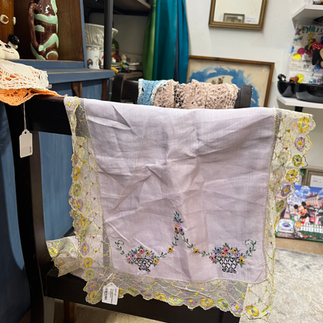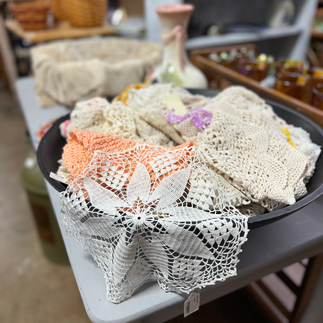Transform Your Home with Timeless Vintage Linens
- America's Antique Mall
- Jul 24, 2023
- 8 min read
Updated: Dec 29, 2025
When you visit an antique store, you're sure to see a vintage linen section. Elegant tablecloths, outdated bedsheet patterns, and crocheted doilies are beloved in the antique community—and for good reason! From the nostalgia of growing up surrounded by grandmother's quilts to the sustainable efforts to use old textiles rather than buying new ones, there are endless reasons people love vintage fabrics. The next time you're strolling around a thrift store, keep your eyes peeled for these valuable and beloved vintage linens.
History of Linen

When you shop for modern linen, chances are that it isn't even real. Vintage linens have a long history in the textile world. Pre-World War 2, they were used in domestic settings, from authentic linen doilies to clothing. But when the war began, natural textiles like linen and cotton were hijacked to make ropes for the Navy, forcing linen companies to turn to polyesters and other textiles to replace classic linens in households. From the 1950s onward, linen became a scarce commodity, and now the use of it is essentially extinct—exactly why people love buying and collecting vintage linens now!
How Do You Spot Vintage Linens?
Believe it or not, identifying linens as vintage is relatively easy. In modern times, many of our quilts, doilies, tablecloths, and more are mass-manufactured by machines, meaning they lack the charm and detail of vintage, handmade linens. Anyone can spot them with the right knowledge, from the vintage fabric used to the handmade elements.
When you're browsing linens, pay attention to the smallest details. Many vintage napkins and blankets feature delicate embroidery details that can only be done by hand. Check the back side of the fabric to see if the threaded knots were done by hand. Hand stitching was also incredibly popular on handkerchiefs and pillowcases, so pay attention to whether the stitches are small, not uniform, and made with one thread. Many vintage napkins, tea towels, doilies, and more featured monogrammed initials on the corner.
Nowadays, many of our linens are made using synthetic textiles, such as polyester or nylon. Real linen fabric has benefits like breathability, durability, and how easy it can be to care for. When hunting for vintage fabrics, make sure you pay attention to exactly what type of material they are made of. While some vintage linens from the '40s may be made with synthetic blends, most pieces are made of more natural fabrics, such as cotton or pure linen.
5 Reasons to Buy Vintage Linens

Sustainability
Sentimentality
Home décor
Built to last
History
No matter who you are or what your style is, there’s a linen perfect for you and your home. If you’ve ever wondered how to make your consumer habits more environmentally friendly or how to enhance your home décor, vintage fabrics could be the answer.
From finding unique gifts for a loved one to wanting to turn a profit at your local antique mall, there are countless reasons to buy vintage linens.
1. Buying Linens is Sustainable
It seems human nature to want to overconsume home goods, including bed sheets, tablecloths, doilies, and towels. People don't realize that antique vendors and thrift stores have linens piled up, unused. Buying used is an amazing way to keep vintage and antique fabric textiles out of landfills and give a second life to these pre-loved duvets, quilts, and more. The next time you need to replace your doilies or find a new seasonal tablecloth, skip the machine-made products and hunt down used linens.
2. Vintage Linens are Sentimental

There's something unique and sentimental about discovering vintage items and buying them for your home. While you could buy a dime-a-dozen bedsheet set at your local retail store, knowing someone spent time and energy hand-crafting quilts, doilies, and tablecloths feels like a personal connection.
Many people buy and collect vintage linens because they remind them of a simpler time, like childhoods spent at grandparents' houses or the coziness of a handmade quilt on the bed during winter. Making the conscious effort to be sentimental and purposeful in buying linens is a great reason to search for them.
3. Vintage Linens Make for Unique Home Décor
Vintage home décor is trendy right now, and handmade vintage fabrics are like snowflakes—every single one is unique. The vintage quilts and doilies you come across will never be made that way again, making them little treasures! Whether looking for a vibrant Afghan throw blanket for your living room or flannel sheets for winter, they will set your home décor apart from the rest. When your guests compliment you on your linens and ask where they can get them, you can proudly say, "They're vintage—practically one of a kind."
4. Vintage Fabrics are Built to Last
There's a reason those linens are still around today—they're all made with high-quality fabric materials designed to last years and years. Have you noticed that modern fabrics, whether doilies or tablecloths, seem to wear out easily? Vintage linen home goods were designed in a time of slower consumer consumption, so they were all meant to last for decades. Investing in these will mean you can buy less and use them longer.
5. A Part of History

Linen has been used in cultures worldwide for thousands of years, from the ancient Phoenicians to 16th-century French royalty. The art of creating vintage linen pieces for the household was lost decades ago, with cheaper and lesser-quality textiles replacing them.
Linen is expensive to make due to the time and skill it takes to weave together. Instead of that, modern clothing and bedsheet companies forgo vintage fabrics and prefer machine-made textiles. So, while buying basic bed sheets from the store seems easier, investing in gorgeous vintage fabric for your home will connect you to the longstanding history of handmade home goods.
The 3 Main Categories of Vintage Fabric
Whether you’re setting up antique booths to sell or scouring online forums for the vintage linen of your dreams, there are three main categories experts use to sort through them:
Bedding
Table linens
Miscellaneous
1. Search for Vintage Bedding

Some of the most popular vintage linen products fall into the bedding category. Whether you're looking to spruce up your guest room with accents or are interested in remaking an entire bed set, these products are commonly found in thrift stores and flea markets around the world.
Antique bedsheets and pillowcases are beyond soft, having been washed and dried repeatedly throughout the years. Handmade crocheted blankets and quilts are unique and something you'll never find in the store. Browse different styles and patterns to make your dream bedding.
Types of Vintage Bedding:
Afghans
Blankets
Quilts
Sheets
Pillowcases
2. Decorate Your Table with Vintage Linens
Add character to any table with unique, vintage table linens. Every table setting detail can be enhanced with vintage designs and pre-loved linens. Throwing on a beautifully crafted tablecloth can make every occasion feel a touch more special. Skip disposable paper napkins and build a collection of vintage napkins instead, so each place setting can be set with reusable ones. Once they get dirty, you can simply toss them in the wash, dry them, and store them away until you're ready to set the table again.
Popular Vintage Table Linens:
Tablecloths
Vintage napkins
Tea towels
Table runners
Hand towels
3. Keep an Eye Out for Miscellaneous Items
Sheets and tablecloths are one thing but don't overlook the various miscellaneous vintage linens at your local antique store. Everything from monogrammed handkerchiefs to handmade doilies can bring a vintage feel to your home décor. Discover unique crochet, lace, and hand-embroidered pieces to personalize every room in your house, from the kitchen table to your bedroom.
Favorite Miscellaneous Vintage Linens:
Handkerchiefs
Crochet
Doilies
How Do You Wash Vintage Linens?

The one downside of buying vintage instead of new is that they may have stains and discolorations—but don't worry, you can wash vintage fabric in no time with a little elbow grease and the right cleaning supplies. When you buy from an experienced vendor, they have been professionally cleaned and ready to use immediately. But you'll need to do it yourself if you happen upon a treasure at a garage sale or thrift store.
Skip the washing machine! Start by soaking them in tepid water to loosen any grime or grit. When the water gets cloudy, replace it with fresh water, repeating this step until it stays clear. Then, fill a tub with lukewarm water, a gentle laundry detergent, and powdered bleach. Slowly mix the vintage fabric with that concoction and rinse well. Finally, lay your vintage linens flat to air dry so they keep their shape.
Pro tip: for stubborn stains, you may need a treatment. Mix equal parts white vinegar and baking soda to create a paste. Apply the paste to the stained area and let it sit for 15-20 minutes. Continue to wash the linen as normal, and voila!
What's the Best Way to Store Vintage Linens?
Properly storing them will elongate their lifespan so you, your children, their children, and so on can enjoy them for years to come. Protect your vintage fabrics from sun damage by storing them in a cool, dark place when they aren't being used. Your hall closet (aptly named the linen closet in many households) is the best place, keeping them off the ground and out of sight. Store the heavier tablecloths, quilts, and blankets on the bottom, with the lighter vintage napkins, handkerchiefs, and doilies on top.
Why Can't Vintage Linens Be Stored in Wood?

Although Grandpa's wood chest may seem like the right place to store your vintage linens, wood can be incredibly dangerous to antique textiles. Wood has acids that can spread to vintage fabrics and cause irreparable stains and damage. So, think twice about storing your antique bedding and table linens in wood drawers and cabinets. If there's no other choice, invest in acid-free tissue paper or unbleached muslin as a barrier between your linen and the wood.
Can Linens Be Valuable?
Vintage linens have a wide range of value, selling from a couple of dollars to hundreds. The price tag generally relies on the condition and age of the vintage fabric. Often, you'll find the cheapest ones at thrift stores or yard sales. The more sought-after ones are often seen at auctions and antique mall events. Sometimes a certain style will sell purely because the buyer loves it.
5 Factors Used to Judge the Value of Vintage Linen
Every detail of an antique quilt or set of vintage napkins can matter when it comes to pricing. Collectors often consider these five factors for vintage fabric:
Condition: stains, tears, fraying threads, and other damage in the design can lower the value.
Quality: high-quality and authentic materials will raise the price.
Scale: larger items are often worth more than smaller items.
Age: older pieces can be sold for more than newer linens.
Details: handmade embroidery or lace details can up the value.
Where Can You Find and Sell Vintage Linen?
Believe it or not, vintage fabrics are often hiding in plain sight. For the most curated spot, head to your local antique mall. Vendors will have complete stocks with authentic vintage options, such as handkerchiefs, Afghans, doilies, and more. At our Algonquin, Highland, or Melbourne antique mall locations, you can browse endless booths and sort through all the collections until you find the ones you love.
Vintage linens are one of the most overlooked and beautiful antique items. Invest in these timeless fabrics and personalize your home décor with unique pieces, from the Afghan blankets in your living room to the handmade crocheted doilies in your dining room.






